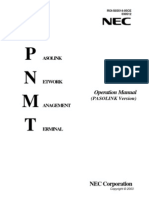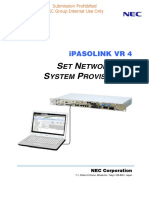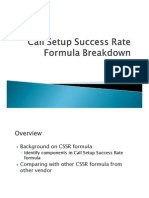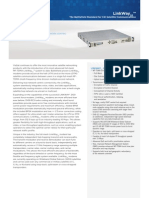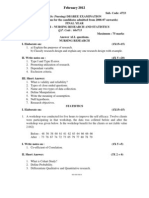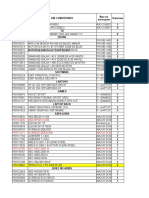SatLink Hub Family - Rev I
SatLink Hub Family - Rev I
Uploaded by
sudanoneCopyright:
Available Formats
SatLink Hub Family - Rev I
SatLink Hub Family - Rev I
Uploaded by
sudanoneOriginal Title
Copyright
Available Formats
Share this document
Did you find this document useful?
Is this content inappropriate?
Copyright:
Available Formats
SatLink Hub Family - Rev I
SatLink Hub Family - Rev I
Uploaded by
sudanoneCopyright:
Available Formats
SatLink Hub Family
for TDM/TDMA Satellite Networks
SatLink Hubs provide the high-performance modems, IP gateway, management and
control functions for all EMC VSAT networks. They implement a TDM/TDMA network in
accord with DVB-S2 & DVB-RCS2 standards, offering Bandwidth-on-Demand, ACM, and
QoS on all carriers, while delivering excellent efficiency, throughput, scalability, and
reliability. The Hub design employs EMCs Open Hub Architecture using a common set of
modules that ease growth and re-configuration. All SatLink networks are fully managed
by the SatLink NMS.
A full range of SatLink Hub configurations are offered from small portable Hubs to carrierclass high-availability Hubs with 99.999% uptime. Hubs configured with redundancy in key
modules can be upgraded with minimal or no disruption to traffic flows.
EMC is the leader in DVB-RCS & DVB-RCS2 networks including: VSATs, Hub Systems, and
Hub components, with value-added options and advanced QoS for data, voice, and
video networking. EMC supplies ISPs, governments, enterprises, and partners around the
world, offering turnkey integration, installation, 24x7
global support, and managed network services.
Example Configurations
(including 1 test VSAT per beam)
9300
9400
9800
SatLink Hub Family
SatLink Hub Feature Comparison
9300
Forward Link
9400
9800
DVB-S2
DVB-S2
DVB-S2
DVB-RCS2
DVB-RCS2
DVB-RCS2
Return Link ACM & QoS
Max # of Beams
10
10
10
Return Link
Forward Link ACM & QoS
# of VSATs
0-1000
0-1000
0-50000
VNO
N:1 or 1:1
N:1 or 1:1
VSN
Return SCPC Mode
TCP Acceleration
Accounting Support
Mesh Topology
Optional
Optional
Commercial TRANSEC
Optional
Optional
Optional
Redundancy
Forward Automatic UPC
Rack Space*
Easily Upgradable
Optional
Optional
Optional
Half-Rack (22U)
1 to 2 Racks (42U)
1 to 3 Racks (42U)
(to 9400)
(to 9800)
*Recommended rack space with room to grow. For a SatLink 9800 Hub expecting 8 or more beams, 3 racks (42 U each) are recommended.
Features & Benefits
Bandwidth Efficiency at Many Levels
The efficiency of DVB-S2 forward links is matched with
DVB-RCS2 return links offering ACM per burst, Adaptive
Carrier Selection (ACS), return carrier spacing down to
1.12x, multiple layers of header compression, and the
most efficient IP encapsulation, with TDMA management that assures no wasted bandwidth.
Comprehensive IP Networking Features
SatLink Hubs integrate full-featured IP routing & TCP &
HTTP acceleration with VPN tunneling, VLANs, & Virtual
Satellite Networks (VSN) for multiple IP address spaces,
and mesh networking routing control (with DVB-RCS).
Advanced Traffic Shaping with QoS
Advanced traffic shaping on Forward and Return Links
with four QoS classes meet the strict requirements for
jitter and/or delay sensitive VoIP, video conferencing,
video streaming, and time critical data applications.
Software-Defined RLS & FLS Platform
The FLS & RLS use EMCs own software-defined modem
platform optimized for processing both IP packets and
the DVB standard waveforms, using EMC firmware &
software running on FPGAs & CPUs. They deliver many
cost reductions and operational benefits, including: high
-efficiency MODCODs, large TDMA carrier groups, fastfeedback ACM integrated with IP QoS, and custom
configurations of carrier groups for maximum efficiency
in burst-mode operation and space & power savings.
High-Availability for Maximum Uptime
Module redundancy using 1:1 or N:1 with fast failover.
Geographic redundancy with multiple RF systems.
SW updates on-the-fly. Uptimes can exceed 99.999%.
ACM, ACS, & Rain Fade Mitigation
With Adaptive Coding and Modulation (ACM) applied
on both Forward and Return Links and Adaptive Carrier
Selection (ACS) on all TDMA carriers, the impact of rain
fades is greatly mitigated, even in Ka band.
Traffic Engineering, VNOs, & VSAT Groups
SatLinks traffic engineering enables cost-effective hub
sharing by controlling bandwidth consumption and QoS
policies of Virtual Network Operators (VNOs) for each of
their VSAT Groups, without assigning hardware or dedicated carriers to particular VNOs.
Comprehensive NMS & NCC Software
EMCs
da tab ase -dri ven
Sa tLi nk
Netwo rk
Management System (NMS) and the SatLink Network
Control Centre (NCC) software optimize network
performance using close-loop control and simplify
the configuration and provisioning of Hub modules,
VSATs, VSAT Groups, carriers, VSNs, and VNOs.
Support for multiple beams, across multiple satellites
on multiple bands (C, Ku, Ka, EHF), including crossstrapped transponders, adds versatility and
scalability.
SatLink Hub Family
SatLink Open Hub Architecture
SatLink Hub design uses EMCs Open Hub
Architecture with commercial off-the-shelf
modules mounted in standard racks with
high-capacity Gigabit Ethernet interconnects. This eases growth and reconfiguration, while also allowing for
integration of 3rd party products for value
-added features. A full range of SatLink
Hub configurations are offered from small
portable Hubs to carrier-class Hubs with
99.999% uptime. All configurations use a
common set of modules.
SatLink 8560 FLS
SatLink NetAcc
(software on EMC supplied servers)
The SatLink 8560 FLS enables DVB-S2 forward link TDM
carriers at up to 45 Msps with ACM for up to 10,000
VSATs. It efficiently combines the functions of a DVB-S2
(or DVB-S) modulator with IP routing, IP encapsulation,
and header compression at 20,000 IP packets per second. ACM is implemented across all supported MODCODs with very low latency and integration with QoS
policies per VSAT, at information rates up to 158 Mbps.
Configurations with N:1 redundancy (N up to 5) are
supported.
SatLink 8560 RLS
The SatLink 8560 RLS enables large DVB-RCS2 return link
capacities by using up to 24 TDMA carriers, up to 8 Msps
each, within a 40 MHz band using ACM per burst, at
1.12x carrier spacing. It is a combination of a DVB-RCS2
(or RCS) burst demodulator with IP packet re-assembly
and header de-compression at up to 20,000 IP packets
per second. The 8560 RLS handles up to 10,000 VSATs
with two QoS classes each, or 5,000 VSATs with four QoS
Classes each. Configurations with N:1 redundancy (N
up to 5) are supported. Multiple active RLS modules
may be assigned to a single active FLS.
The SatLink NetAcc software delivers high-performing
TCP acceleration while also implementing IP routing,
QoS policy enforcement, and traffic shaping, as well as
optional user accounting and fair use policy control. It
supports up to 10,000 VSATs with 25,000 bi-directional
accelerated TCP sessions, with up to 10 Mbps of TCP
throughput in a single direction. Total capacity is rated
at 150 Mbps on the supplied multi-core servers. Each
NetAcc server supports multiple FLS/RLS. Configurations
with N:1 redundancy (N up to 5) are supported.
SatLink NMS & NCC
(software on EMC supplied servers)
The SatLink Network Management System (NMS) and
Network Control Centre (NCC) software hold the keys to
high-performance management & control. In smaller
Hubs both of these software functions run on the same
server with redundancy implemented as 1:1. In the 9800
Hub these functions run across multiple servers with
great scalability for the NCC by using N:1 redundancy.
In the 9800 Hub the NMS is 1:1 redundant and uses a
high-availability disk cluster system. The NMS oversees
the health and automatic switchovers of all other
SatLink modules used in the Hub.
SatLink Hub Family
for TDM/TDMA Satellite Networks
Specifications
Compression & Encryption
Header Compression: MPE, UDP/IP, and RTP/UDP/IP
TRANSEC: AES-256 encryption on Layer 2 (optional)
IP Routing
Terrestrial-Side Routing: RIP V2, OSPF, BGP, MPLS Edge
(Requires IP Router or L3 switch option)
Satellite-Side Routing (in FLS): Dynamically linked to
NMS set-up of each VSAT, VNO, & VSN
Multicast IP: Multicast IP forwarding & IGMP at VSAT
VSN/VLANs: Virtual Satellite Networks, each with independent IP address spaces, using 802.1Q VLANs in Hub
Shaping/QoS & Acceleration
Traffic Shaping: Shaping with rate limiting per VSAT and
per VSAT Group; Granularity of 2 kbps for Bandwidthon-Demand, 1 kbps for CRA
QoS: 4 different QoS Classes, 7 queues; multi-field IP
packet classification rules in headers at Layers 2, 3, & 4
on Forward and Return (plus Mesh Links with DVB-RCS)
TCP Acceleration: Up to 10 Mbps per connection; up to
25,000 accelerated bi-directional TCP sessions per
Network Accelerator module
Time & Frequency References
Time Protocols: TP (RFC 868)/ NTP (RFC 1305)
Frequency Stability: 10-9 or better if slaved to GPS
NCR Stability: Better than 37ns with respect to UTC
Compliance
CE: Fully compliant with R&TTE Directive
DVB-RCS2: ETSI EN 301 545-2
DVB-RCS: ETSI EN 301 790
DVB-S2: ETSI EN 302 307
International: Country specific certifications
TDM Forward Links (DVB-S2)
Symbol Rates: 1 to 45 Msps, increments of 100 sps
Outer/Inner FEC: BCH/LDPC
MODCODs:
QPSK: 1/4, 1/3, 2/5, 1/2, 3/5, 2/3, 3/4, 4/5, 5/6, 8/9, 9/10
8PSK: 3/5, 2/3, 3/4, 5/6, 8/9, 9/10
16APSK: 2/3, 3/4, 4/5, 5/6, 8/9, 9/10
32APSK: 3/4, 4/5, 5/6, 8/9, 9/10
ACM: Full-range or custom list, plus min & max MODCOD
configurable by VSAT
FEC Frames: Normal (64 Kbit) and Short (16 Kbit)
Roll-off Factor: 20%, 25%, or 35%
Automatic UPC: Built-in to FLS (requires beacon receiver)
IP Encapsulation: GSE or MPE/MPEG-TS
TDMA Return Links (DVB-RCS2)
Symbol Rates: 125 Ksps to 8 Msps
FEC Type: 16-State Turbo Code
MODCODs:
BPSK: 1/3, 1/2
QPSK: 1/3, 1/2, 2/3, 3/4, 5/6
8PSK: 2/3, 3/4, 5/6
16QAM: 3/4, 5/6
ACM: Full-range with min & max MODCOD configurable
by VSAT
Carrier Spacing: As low as 1.12x symbol rate
TDMA Carriers per RLS: up to 24 in a 40 MHz band
IP Encapsulation: RLE per standard
Option for DVB-RCS: Selectable by RLS instance
SatLink NMS & NCC: Highlights
Database: Oracle with back-up, restore, & roll-back
VNOs (Virtual Network Operators): Access controls for
each staff member of a VNO, no extra HW required
VSAT Groups: 24 VSAT Groups per TDMA Carrier Group
Capacity Requests: Rate, Volume, & Combined Mode
VSAT Provisioning: Web-based, fast and simple
MF-TDMA Resource Control: Assignment policies per QoS
class by VSAT and VSAT Group; customized superframes
from 70 to 250 msec; ACS assigns feasible symbol rate
MF-TDMA Frame Structure: May be tailored per carrier
Topologies: Star (and Mesh or Hybrid with DVB-RCS)
OSS/BSS Integration with SatLink NMS: North-bound software integration interface provided via SOAP
www.emc-corp.net
Emerging Markets Communications | 777 Brickell Avenue, Suite 1150 | Miami, FL 33131, USA
T +1 305 539 1358 | FAX +1 786 425 0679
All specifications and features subject to change without notice. EMC reserves the right to discontinue the SatLink 1000 model at any time and provide a replacement model such as the
SatLink 2000 with equal or better features. SatLink is a registered trademark of Emerging Markets Communications.
The DVB-RCS & DVB-RCS2 logos are registered trademarks of the DVB Project (www.DVB.org). Oracle is a trademark of Oracle Corp.
Document #200690; Revision I - 140225 2014
You might also like
- Astm A370-22Document51 pagesAstm A370-22Edwin Juan Cristobal VilcaNo ratings yet
- DVB S2x en - 30230702v010101aDocument139 pagesDVB S2x en - 30230702v010101aPaola Escobari0% (1)
- Nortel S8000/S12000 CEATS InstallDocument57 pagesNortel S8000/S12000 CEATS Installkcchiefs00No ratings yet
- Siemens FMX 1Document32 pagesSiemens FMX 1Nicolaie NicusorNo ratings yet
- Huawei OMC IManager M2000 Engineering Parameters IntroductionDocument11 pagesHuawei OMC IManager M2000 Engineering Parameters IntroductionaricomenNo ratings yet
- First Filling of Pressure TunnelsDocument13 pagesFirst Filling of Pressure TunnelstnvishNo ratings yet
- Viasat Linkstar Modem DVB s2 VsatDocument4 pagesViasat Linkstar Modem DVB s2 VsatNasreddine BaoucheNo ratings yet
- Linkstar Installation ManualDocument10 pagesLinkstar Installation Manualkg413No ratings yet
- PNMT (Pasolink) Operation ManualDocument52 pagesPNMT (Pasolink) Operation ManualAsrar Zaffar50% (2)
- InfiMONITOR v1 20160727 - 2010 PDFDocument79 pagesInfiMONITOR v1 20160727 - 2010 PDFAntonio Marcos RockenbahNo ratings yet
- Euro TekDocument81 pagesEuro TektunisianouNo ratings yet
- ATP Form For VSAT ISAT - KadugliDocument9 pagesATP Form For VSAT ISAT - KadugliAhmed N. MusaNo ratings yet
- 1 IOM - Introduction, 030106Document20 pages1 IOM - Introduction, 030106Анатолий МаловNo ratings yet
- PNMT (Pasolink V4)Document52 pagesPNMT (Pasolink V4)azzhalim67% (3)
- Get Recording Studio Design 4th Edition Philip Richard Newell PDF ebook with Full Chapters NowDocument50 pagesGet Recording Studio Design 4th Edition Philip Richard Newell PDF ebook with Full Chapters Nowobienagota95100% (8)
- Sagem Adr 155c User Manual PDFDocument134 pagesSagem Adr 155c User Manual PDFJesus Lopez100% (1)
- MODEM CMD 760 DatasheetDocument441 pagesMODEM CMD 760 Datasheetjonathan firacativeNo ratings yet
- Ra'ed AL-Omari: Telecommunication and Radio Networking Engineer With 15+ Years of Industry ExperienceDocument4 pagesRa'ed AL-Omari: Telecommunication and Radio Networking Engineer With 15+ Years of Industry ExperienceMohamed EmadNo ratings yet
- SATCorp Monics OverviewDocument4 pagesSATCorp Monics OverviewarzeszutNo ratings yet
- T REC E.212 201807 I!Amd1!PDF EDocument28 pagesT REC E.212 201807 I!Amd1!PDF ECedric KerkettaNo ratings yet
- 3 Hardware PDFDocument64 pages3 Hardware PDFBojan Banjac67% (3)
- Newtec MDM9000 Satellite Modem r3.3 DatasheetDocument4 pagesNewtec MDM9000 Satellite Modem r3.3 DatasheetarzeszutNo ratings yet
- Telecom 101: The Evolution of TelecommunicationsDocument1 pageTelecom 101: The Evolution of Telecommunicationsaljarrah84No ratings yet
- Quality of Service Qos: Setup Guide Document Version 3.4 May 2017Document21 pagesQuality of Service Qos: Setup Guide Document Version 3.4 May 2017Jean-Franco Acosta0% (1)
- Kymeta KyWay Go - Data SheetDocument2 pagesKymeta KyWay Go - Data SheetAmit sharmaNo ratings yet
- Manual Do ProdutoDocument71 pagesManual Do ProdutocarlosNo ratings yet
- MN cdm760Document276 pagesMN cdm760Columbus FonjockNo ratings yet
- Siemens FMX 2Document252 pagesSiemens FMX 2Nicolaie Nicusor100% (1)
- JD For Telecom Maintenance EngineerDocument2 pagesJD For Telecom Maintenance EngineerSaud HassanNo ratings yet
- KPI Parameters NotesDocument3 pagesKPI Parameters Notesqudratullah ehsanNo ratings yet
- Qualcomm UMTS OverviewDocument4 pagesQualcomm UMTS OverviewJalal HalamedhNo ratings yet
- Amc 300 Version 1.60Document49 pagesAmc 300 Version 1.60hendpraz88No ratings yet
- Huawei Firewall EudemonDocument16 pagesHuawei Firewall Eudemonakram_alqadasiitNo ratings yet
- Ua5000 Ipmsan NGN Service ConfigurationDocument21 pagesUa5000 Ipmsan NGN Service ConfigurationHudzrul NizamNo ratings yet
- NetDe - Sign - 11 - Selecting Technologies For Campus NetworkDocument19 pagesNetDe - Sign - 11 - Selecting Technologies For Campus NetworkphamthientrungNo ratings yet
- VR4 04 GGS-000393-06E NW-SYS-PROV NoRestriction PDFDocument726 pagesVR4 04 GGS-000393-06E NW-SYS-PROV NoRestriction PDF1No ratings yet
- Microwave TransmissionDocument14 pagesMicrowave TransmissionEyu LakeNo ratings yet
- Huawei Optix Osn 8800 t16 DatasheetDocument3 pagesHuawei Optix Osn 8800 t16 Datasheetimran nazirNo ratings yet
- Newtec Overview PDFDocument88 pagesNewtec Overview PDFJames RogersNo ratings yet
- Net Modem CMD List (Idirect 5000)Document9 pagesNet Modem CMD List (Idirect 5000)Patrick SatchellNo ratings yet
- BTS OverviewDocument12 pagesBTS OverviewDiwakar Mishra100% (1)
- Codan Envoy HF Smart Radio EN2Document3 pagesCodan Envoy HF Smart Radio EN2dot16eNo ratings yet
- Vsat Bandwidth Efficiency On Satpath SystemDocument10 pagesVsat Bandwidth Efficiency On Satpath SystemInternational Journal of Innovative Science and Research TechnologyNo ratings yet
- Ateme Datasheet Titan Edge Enc 2024 AprilDocument2 pagesAteme Datasheet Titan Edge Enc 2024 AprilRahulNo ratings yet
- Alcatel 9135 OMC-Radio PDFDocument43 pagesAlcatel 9135 OMC-Radio PDFalgor1959No ratings yet
- Call Setup Success Rate Formula BreakdownDocument14 pagesCall Setup Success Rate Formula BreakdownRajesh Annapurani0% (1)
- ADS Oscillator DesignDocument23 pagesADS Oscillator Designnavvaba100% (1)
- Drss Irss 7.8km: 1 Example - Tetra Ms Interferers The Bs of The Analogue FM PMR 1.1 Scenario OverviewDocument9 pagesDrss Irss 7.8km: 1 Example - Tetra Ms Interferers The Bs of The Analogue FM PMR 1.1 Scenario OverviewkamalNo ratings yet
- PMP 450 Release Notes - System Release 21.1.0.1Document16 pagesPMP 450 Release Notes - System Release 21.1.0.1György SimonNo ratings yet
- Atoll CDMA PlanningDocument14 pagesAtoll CDMA PlanningMoayed YagoutNo ratings yet
- SatLink Hub Family - Rev J PSNDocument4 pagesSatLink Hub Family - Rev J PSNDiego Gabriel IriarteNo ratings yet
- LinkWay S2 Datasheet 012 WebDocument2 pagesLinkWay S2 Datasheet 012 Webvsharma26No ratings yet
- Newtec MCX7000 Multi Carrier Satellite Gateway r2.4 DatasheetDocument4 pagesNewtec MCX7000 Multi Carrier Satellite Gateway r2.4 DatasheetarzeszutNo ratings yet
- Satlink 1000 Vsat - Rev oDocument2 pagesSatlink 1000 Vsat - Rev oAhmad Maqsood BaigNo ratings yet
- ProductSheet MCX8000121212Document8 pagesProductSheet MCX8000121212alexggggNo ratings yet
- Romantis UHP 1000 WebDocument2 pagesRomantis UHP 1000 WebPurwa TmNo ratings yet
- SatLink 2900 Mobile VSAT - Rev K - 0Document2 pagesSatLink 2900 Mobile VSAT - Rev K - 0Christian Starchy Mimeck'sNo ratings yet
- MDM6000 Satellite Modem R2.0Document4 pagesMDM6000 Satellite Modem R2.0gabyayanNo ratings yet
- Newtec MCX7000 Multi Carrier Satellite Gateway ModemDocument4 pagesNewtec MCX7000 Multi Carrier Satellite Gateway ModemarzeszutNo ratings yet
- PTP 820 SeriesDocument4 pagesPTP 820 SeriesratrivertechNo ratings yet
- Power Sensor ManualDocument52 pagesPower Sensor Manualkamtung100% (1)
- 15052-E N-Extruder 02 PDFDocument4 pages15052-E N-Extruder 02 PDFFaiia TallerNo ratings yet
- GRCon17 Program 1Document1 pageGRCon17 Program 1Saleem AzharNo ratings yet
- PUshbuttonsDocument361 pagesPUshbuttonsArmin Kovačević100% (1)
- FFFF PDFDocument2 pagesFFFF PDFYvonneNo ratings yet
- Tower CranesDocument20 pagesTower CranesashkansoheylNo ratings yet
- Tug As Slide 71 MaharDocument7 pagesTug As Slide 71 MaharmahardputraNo ratings yet
- Nabl 122 02 PDFDocument24 pagesNabl 122 02 PDFmaheshNo ratings yet
- Dubai Universal Design Code Final Feb 2017Document11 pagesDubai Universal Design Code Final Feb 2017TahaMustahsan100% (1)
- Sainath College of Nursing, KatniDocument4 pagesSainath College of Nursing, KatniFabin JoseNo ratings yet
- Bird Bird Guide To The General Data Protection RegulationDocument82 pagesBird Bird Guide To The General Data Protection RegulationLong TranNo ratings yet
- Introduction To FieldbusDocument28 pagesIntroduction To Fieldbusnour100% (1)
- LG Safety and Reference GuideDocument24 pagesLG Safety and Reference GuideratulmkNo ratings yet
- Spi ModuleDocument13 pagesSpi ModuleMuhammadSaeedTahir100% (2)
- Understanding of ISO9000 StandardsDocument36 pagesUnderstanding of ISO9000 StandardsLove100% (1)
- MBA-405 - Topic 4 - Management AccountantDocument4 pagesMBA-405 - Topic 4 - Management AccountantHanna Vi B. PolidoNo ratings yet
- AX aFleX Ref v2 4 3-20100621Document166 pagesAX aFleX Ref v2 4 3-20100621uping_ttNo ratings yet
- End User Devices Security Guidance: Ubuntu 12.04: Gov - UkDocument10 pagesEnd User Devices Security Guidance: Ubuntu 12.04: Gov - Uked ricksNo ratings yet
- Entrepreneurship - Ch13 - Reasons For GrowthDocument30 pagesEntrepreneurship - Ch13 - Reasons For GrowthHtet Pyae ZawNo ratings yet
- Audit Checklist - SampleDocument4 pagesAudit Checklist - SampleJohan HunterNo ratings yet
- Vag Com 11.11Document9 pagesVag Com 11.11Eduardo Corona100% (1)
- 7.radiation Protection and Regulatory Aspects 02-04-2024Document52 pages7.radiation Protection and Regulatory Aspects 02-04-2024aeromac33No ratings yet
- РАЗЛИКИ 200002Document31 pagesРАЗЛИКИ 200002MamattiNo ratings yet
- Configuring and Administering ServerDocument100 pagesConfiguring and Administering ServerHaftamu Hailu100% (5)
- Guidelines On Product Chemistry Data Requirement (Malaysia)Document31 pagesGuidelines On Product Chemistry Data Requirement (Malaysia)Vimarsha HSNo ratings yet
- SQA - Aircraft Performance AnalystDocument3 pagesSQA - Aircraft Performance AnalystJessica TangNo ratings yet
- MBA Application FormDocument4 pagesMBA Application FormSaurabh MishraNo ratings yet








